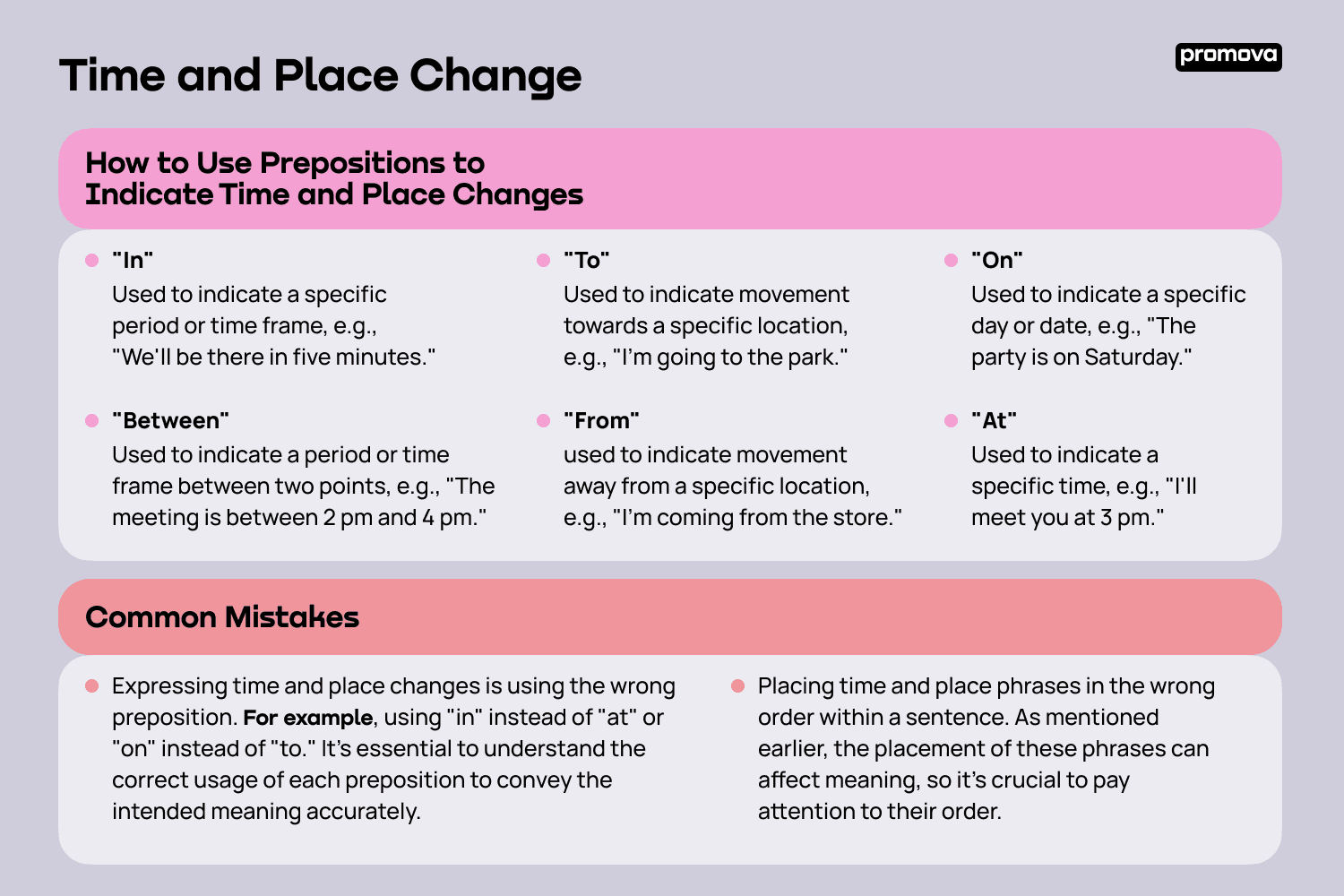Time and Place Change
Contents
Many English language learners find it hard to convey time and place correctly. In this reference, we will explore common phrases and prepositions used to indicate time and place changes, provide examples of their usage, and address common mistakes. Let's start learning!
How We Show Time and Place
Before we dive into the specifics of expressing time and place changes, let's first discuss how we typically show these concepts in English.
Time and place can be indicated using various phrases, prepositions, and verbs. For example, we might use "at," "in," "on," "to," "from," "between," and "among." Additionally, we can use verbs such as "go," "come," "arrive," "leave," "return," and "travel" to express movement or change in location.
Common Phrases for Expressing Time and Place Changes
- A common phrase used to express it is "this time this place." This phrase is often used when referring to a specific event or meeting. For example, "I'll meet you at the coffee shop at 2 pm. This time, this place."
- Another common variant is "time and place." This phrase can be used to refer to a general time and location. For example, "The concert will be held at the stadium on Friday night. Time and place are subject to change."
- Lastly, we have "place and time." This phrase is similar to "time and place," but the order is reversed. For example, "We'll have dinner at the restaurant at 7 pm. Place and time are confirmed."

How to Use Prepositions to Indicate Time and Place Changes
Prepositions are an essential part of the English language, and they play a significant role in expressing time and place changes. Here are some prepositions used to indicate time and place changes and their corresponding usage:
- "At" - used to indicate a specific time, e.g., "I'll meet you at 3 pm."
- "In" - used to indicate a specific period or time frame, e.g., "We'll be there in five minutes."
- "On" - used to indicate a specific day or date, e.g., "The party is on Saturday."
- "To" - used to indicate movement towards a specific location, e.g., "I'm going to the park."
- "From" - used to indicate movement away from a specific location, e.g., "I'm coming from the store."
- "Between" - used to indicate a period or time frame between two points, e.g., "The meeting is between 2 pm and 4 pm."
Examples of Time and Place Changes in English Writing
Let's check out some examples:
"I arrived at the airport at 6 am and boarded my flight to Paris at 8 am. The time and the place were perfect for me."
In this example, "at" is used to indicate a specific time (6 am) and location (the airport). The phrase "the time and the place" is used to refer to the overall suitability of the situation.
"After spending a week in New York City, I returned home to Los Angeles on Sunday. The change in place was welcome, but the time change was challenging."
In this example, "in" is used to indicate a specific period (a week) and location (New York City). "To" is used to indicate movement towards a specific location (Los Angeles). The phrase "time change" refers to the difference in time zones between New York and Los Angeles.
"I'm looking forward to our meeting tomorrow. This time this place works well for me."
In this example, "tomorrow" is used to indicate a specific day. The phrase "this time this place" is used to refer to the specific time and location of the meeting.
When Does the Time Change Take Place in Sentence Structure?
It's important to note that the placement of time and place phrases within a sentence can affect meaning. For example, consider the following two sentences:
"I arrived at the airport at 6 am and boarded my flight to Paris at 8 am."
"I boarded my flight to Paris at 8 am and arrived at the airport at 6 am."
In the first sentence, the time and place phrase "at the airport at 6 am" comes before the verb "boarded," indicating that the speaker arrived at the airport before boarding the flight. In the second sentence, the time and place phrase "at the airport at 6 am" comes after the verb "boarded," indicating that the speaker boarded the flight before arriving at the airport.
6
Common Mistakes
- Expressing time and place changes is using the wrong preposition. For example, using "in" instead of "at" or "on" instead of "to." It's essential to understand the correct usage of each preposition to convey the intended meaning accurately.
- Placing time and place phrases in the wrong order within a sentence. As mentioned earlier, the placement of these phrases can affect meaning, so it's crucial to pay attention to their order.
Summary
We can use various phrases, prepositions, and verbs to convey place and time concepts accurately. By using the correct prepositions and paying attention to the order of phrases within a sentence, we can avoid common mistakes and communicate our intended meaning effectively. Keep practicing, and soon you'll be a pro at expressing all sorts of concepts in English!
Comments